I remember when I first started studying Japanese well over 10 years ago, what could I possibly read at this level? Japanese is such a complicated language because you have to know 2000+ characters to read it (well/easily). Some other languages, that are based on roman characters are slightly easier to get into because you can read it from day one. You have a general idea of how to say the words too.
But that is not the case for Japanese. So, if you are thinking about taking the N5 test, you might be wondering to yourself what the reading could possibly be like with such a limited vocabulary and limited knowledge of kanji. Amazingly, you can convey quite a bit of things.
The same could be said about speaking at this level of course. What can you possibly say with the 600 words that are covered at the N5 level? Well, with a little practice you can say and write a lot with that set of words. You just have to practice with it a little bit.
And, I know what you are saying your head. “But Mac! I never know the words for what I want to say. It’s so frustrating!” Yeah, it is a bit rough. When you started riding your bike, you probably fell down a lot, you probably didn’t go very fast, but over time you got better and more skilled. And now, riding a bike is probably second nature to you.
You have to start somewhere, so if you haven’t already started doing some writing, now is a good time to start, even if you are at an N5 level. And doing some writing at this level will give you a good idea of what kind of topics will be covered on the test. So when you get into the test you will be confident with what you need to read.
The N5 Reading Section
So let’s talk about the N5 reading section. Let’s be honest with ourselves. There are only a limited set of topics that can appear in this section of the test. You are not going to see an essay about someone musing on what it is like to go to an onsen and see all the naked people there, which was an actual example from one of my reading textbooks for N1.
You aren’t going to have to sift through that. You will most likely see notes, flyers, short dialogs that focus around very common daily activities. They will be on things like trips you took, things you ate or did and come in the form of instructions, warnings or basic advertisements. Very common everyday things that you would probably see if you lived in Japan.
And it can be incredibly difficult to find material that mimics this level outside of ‘prepared’ material, things written specifically for the test. This a very common question I get from readers. And I always have to tell them that the best source material is from paid sources.
There are a few places you can pick children’s books for low cost or practically free. However, they are full of a lot of onomatopoeia and other children’s words that might not be all that useful if you are looking to make the most of your time studying for the test. They are fun to read though and it is a very good feeling when you complete your first kids book and understand it completely.
You can pick up some graded readers that are written with learner’s in mind. They can be quite pricey, but they include listening materials for you to review with and are a great way to learn and familiarize yourself with vocabulary instead of drilling away at your stack of items on Memrise or Anki.
The other option is write your own stuff. Once you go through the steps of trying to create your own content, you start to realize the limitations the test makers have for creating the test. It really helps you to understand that the amount of things they can write about is pretty finite.
I had a lot of trouble myself writing something with a limited vocabulary, but once I got started it was pretty easy to keep going. And forcing yourself into this small box can help you become more fluent. So give it a try already!
Below you’ll find two sample reading questions that I whipped up for you. I challenge you to come up with some reading passages of your own. If you do, be sure to get them checked on lang-8.com and post a link here in the comments. Do it now, you’ll thank me later.
いつも
1)
a)
b)
c)
d)
ちえこは おかしが だいすきです。 でも、
2) ちえこは どうして
a)あまいものを
b)あまり はしらなかったからです。
c)くだものを
d)
3) ちえこは どう なりましたか。
a)
b)おかしを
c)
d)ほそく なりました
What are the answers? Give it your best shot in the comments below (and no cheating if you already passed N5).
JLPT N5 Resources
JEES has made the official JLPT N5 Workbook available for download free. The N5 workbook is pretty close to the same size as the real test and the questions are made up of questions from previous exams. Also it is free, so if you have the time, be sure to download it and give it a try.

This is a great book that really focuses on the reading section of the test and gives you plenty of examples to test your reading skills. Not only does it have examples, it also walks you through some great reading strategies for that section. If you are having trouble with the reading section of the N5, this is the book to get.
 Japanese Pod 101 Old Level 4/N5 Prep Course
Japanese Pod 101 Old Level 4/N5 Prep Course
Japanese Pod 101 has a 6 lesson last minute prep course for the test as well as additional practice tests. Also, their lessons are sorted by grammar points, so if you are having problems with a particular point, it is a great place to focus in on the one point that is giving you some trouble.













These are tricky questions! I think the answers are…
1) d
2) a
3) d
(Dad!)
By the way, I noticed that question 1 has two “b” answers. Just thought you might like to know!
Oops! Something obviously got mixed up there. But, you got it DAD! I just realized this is actually a little tougher than N5. It’s bit N4ish. Great work!
Please let me know if these answers are right.
1. (b)
2. (d)
3. (a)
Actually, it should 1) D 2) A 3) D
How long have you been studying? Was the grammar tough? Vocabulary?
my answer was DAB at first when I read it the 2nd and 3rd time.. there I only understand.. no. 3 question is a tricky one.. haha.. some of the conjugations I have not yet encountered. my final answer is DAD..
Best
Hi, my name is Clinaka well I work in a clinic as a dentist so I’ve been studying n5 so I did this quiz and it was very helpful thankyou these are my answers for the questions you have given above. 1) d, 2) a, 3) d. please let me know if they’re right and please make sure you stay safe, bye.